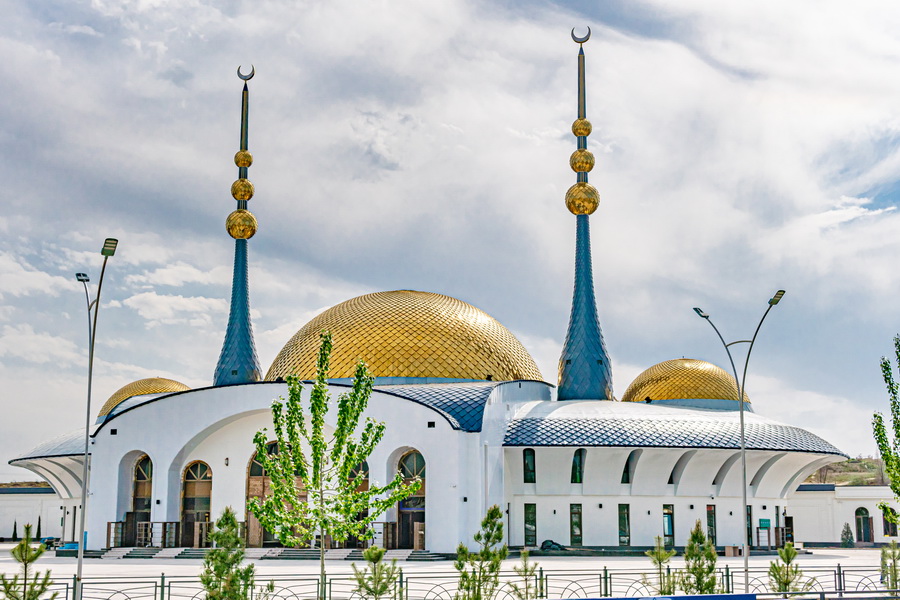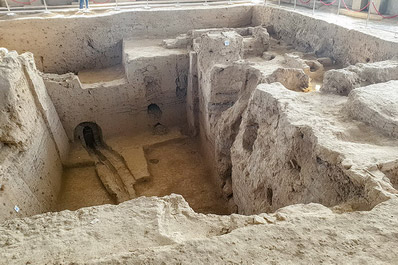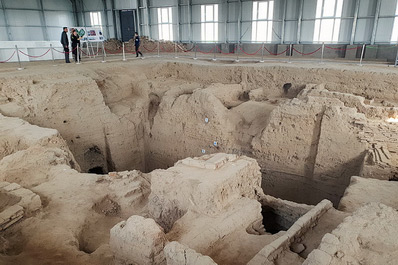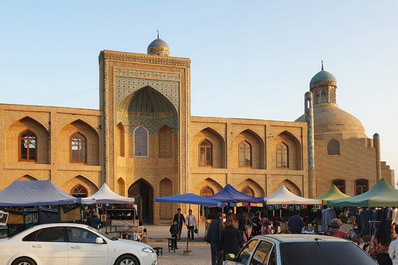Namangan, Uzbekistan

Namangan, located in the Fergana Valley, is a vibrant and green city with a population of over 626,000 residents. It is the second most populous city in Uzbekistan, after Tashkent.
Since 1961, Namangan has hosted an annual flower festival, which became international in 2019. The festival features live and artificial floral compositions shaped into insects, animals, flags, and coats of arms, decorating arches and vehicles throughout the city. Held in May-June, the event attracts florists and flower enthusiasts from across Uzbekistan and has welcomed guests from Russia, Central Asia, South Korea, India, Turkey, Iran, and the Netherlands.
Beyond its natural beauty, Namangan is home to numerous archaeological and architectural monuments, offering a glimpse into its rich history. The city is also famous for its artisans, who continue to create exquisite handmade crafts, preserving the traditions of Uzbek craftsmanship.
Brief History of Namangan
The territory of modern Namangan has been inhabited for over 2,000 years. Some historians believe that in ancient times, a lake in the area was used for salt extraction, giving the city its name—"Naman Kan", meaning "salt mine." However, this theory is debated, as there are no known salt deposits in or around Namangan.
Namangan was first mentioned in written records in the late 15th century as a small settlement. It officially gained city status in 1610, and just a decade later, it became home to the residents of ancient Aksikent (Akhsikent), who relocated after their city was destroyed by a devastating earthquake.
During the Middle Ages, Namangan flourished as a center of craftsmanship, home to jewelers, potters, shoemakers, blacksmiths, and weavers. To this day, the city is renowned for its handmade products, which are exported to Russia, Georgia, Kazakhstan, and Europe.
Namangan was once part of the Kokand Khanate, a period marked by frequent ruler changes—one of them, Murad Khan, ruled for only 11 days. In the second half of the 19th century, Namangan was annexed by the Russian Empire. Several buildings from this era remain, including the former Russian-Asian Bank building, a historical landmark from that time.
How to Get to Namangan
The most convenient way to reach Namangan is by airplane, with regular flights connecting the city to Tashkent, Moscow, Sochi, Ufa, Yekaterinburg, Irkutsk, Perm, Nizhnevartovsk, Krasnoyarsk, Omsk, Samara, Makhachkala, Al Kuwait, Sharjah, and Dubai.
For those who prefer train travel, Namangan can be reached from Tashkent, Kungrad, and Urgench. Some trains also make short stops in Nukus, Bukhara, Navoi, Samarkand, and smaller towns along the route.
Alternatively, you can take a shuttle bus or minibus from major cities across Uzbekistan. A private taxi is another option, offering direct transport from any city or settlement in the country.
Traveling by road may not be the most convenient option, but it is undoubtedly the most scenic. The journey passes through the breathtaking Kamchik Pass, where you can stop to admire stunning mountain views, making the trip an experience in itself.
Namangan Attractions
The Mausoleum of Khoja Amin (Khojamin Kabra) was built in 1725 and, although only partially preserved, it still reflects pre-Mongol architectural influences. Its walls are decorated with carved terracotta, and inside, Arabic inscriptions from poems of visiting pilgrims can be seen. In the 20th century, a wooden mosque was built next to the mausoleum.
The Mavlon-buva Complex, also known as Mavlaviy Namangani, was originally a small mausoleum dedicated to the poet Mavlon, who lived centuries ago. In the early 19th century, it was expanded into a beautiful religious complex that now includes a mosque and a park. Inside the mosque, fragments of old paintings and fine wood-carved decorative elements have been preserved.
The Ataullahan-Tura Mosque (Atuullohon or Ota Valihon-Tura Mosque) is located on Namangan’s main street. Originally built in the 18th century, it was rebuilt in 1914. Some sources state that the mosque’s dome, with a 14-meter diameter, is the largest in Central Asia among mosques constructed between the 16th and 19th centuries. A madrasah, Mulla-Kirgiz, was once attached to the mosque but moved to a new location in 2016, leaving the original historic buildings intact for visitors to admire.
The Mulla-Bazar-Okhund Memorial Complex consists of a mausoleum, a mosque, and an inner courtyard with a pond. According to legend, before the 18th century, Namangan residents buried their relatives in their own courtyards. The mullah Mulla-Bazar-Okhund is said to have opposed this practice and requested to be buried outside the city, setting a new tradition.
The mahallas (traditional neighborhoods) of Namangan are a unique attraction, often said to be even more colorful than those of old Samarkand. Walking through these narrow, winding streets provides a glimpse into local life, though visitors should be mindful not to get lost in the labyrinthine alleys.
For history enthusiasts, a visit to Aksikent (Akhsikent) is a must. This ancient settlement, founded in the 3rd-2nd centuries BCE, was once the capital of the Fergana Valley in the Middle Ages. However, a powerful earthquake more than 400 years ago left it in ruins. Many artifacts from Aksikent’s archaeological excavations are displayed at the Namangan Regional Museum of Local Lore.
Just 14 kilometers from Namangan, the town of Turakurgan is home to the Gayibnazar (Gaynazar) Madrasah, a well-preserved religious school built in the late 19th century.
The mountain village of Chadak is a place of living history. Scientists believe people have lived here for over 4,000 years. Walking through its narrow streets, visitors can see elders in traditional turbans, experience the hospitality of locals, and even receive an unexpected tea invitation from a stranger—a testament to Uzbek warmth and tradition.
One of Chadak’s natural wonders is the Weeping Rock, a small waterfall formed by melting snow. The thin streams of water trickling down the moss-covered rock resemble tears, and it is said that even in winter, the water never freezes.
In the Chust district of Namangan region, the archaeological site of Bibiona (Bibi Ona) dates back to the 10th-8th centuries BCE. This ancient site has yielded important artifacts, and it is also home to a holy spring, which pilgrims of different religions visit, believing the water has healing properties for infertility and vision problems.
Another sacred site in Chust is the Mavlono Lutfillo Complex, which also features a holy spring visited by those seeking blessings and healing.
Located 25 kilometers from Namangan, the Chartak Balneological Resort is a famous wellness retreat, offering visitors the chance to bathe in mineral springs and benefit from the healing properties of therapeutic muds.
Shopping in Namangan
Just outside Namangan lies Chust, an ancient town renowned for its handcrafted knives (pichaks or pchaks), which have been made here for centuries. These strong, durable, and beautifully designed knives are not only practical but are also used as decorative pieces due to their intricately crafted handles. A visit to the Chust quarter of craftsmen offers a chance to purchase an authentic knife and observe hereditary artisans, some working in their seventh generation, as they skillfully forge these traditional blades.
While in Chust, be sure to explore the local embroidery workshops, where artisans craft skullcaps (tubeteikas) distinct from those found elsewhere in Uzbekistan. Chust skullcaps are taller than traditional designs and feature exquisite hand embroidery, making them a unique souvenir.
For a broader selection of local crafts, the shopping complex inside the "Valley of Legends" amusement park offers products made by Namangan's weavers, jewelers, and other skilled artisans.
Visitors to Namangan often seek out the region’s famous cauldrons (kazan), essential cookware for Uzbek cuisine. Made of cast iron with thick walls, these cauldrons come in two shapes: large, semicircular ones with convex bottoms for cooking over an open fire and smaller, flat-bottomed ones for home use. Food cooked in a cast-iron kazan never burns, making it a prized kitchen item.
No visit to Namangan is complete without tasting its famous apples, best found at Chorsu Market. These apples gained widespread recognition after the popular 1960s song "Namangan Apples", a legacy that continues to this day.
Food in Namangan
Namangan is home to several regional dishes that are unique to this area.
One of the most distinctive varieties of pilaf in Namangan is made using Devzira rice, a brownish-hued grain primarily grown in the Fergana Valley. This aromatic and slightly chewy rice gives the dish a rich texture and deep flavor.
Dumgaza shurpa is a hearty soup made with vegetables and oxtail. While the idea of oxtail may not sound appealing to everyone, the dish is fragrant, flavorful, and free from any strong odors, making it a favorite among locals.
Another beloved dish is shavlya, a rice-based meal similar to pilaf, prepared with meat, mochi (fatty lamb), onions, and a blend of spices. It is known for its soft, creamy consistency, offering a comforting and rich taste.





